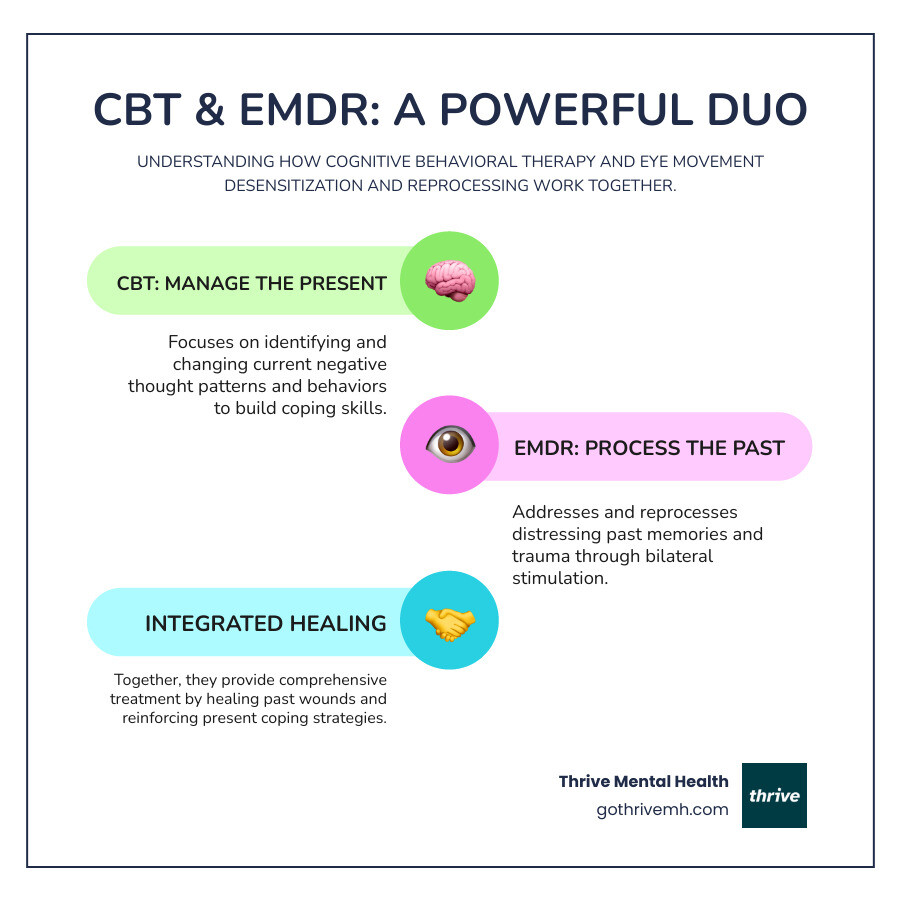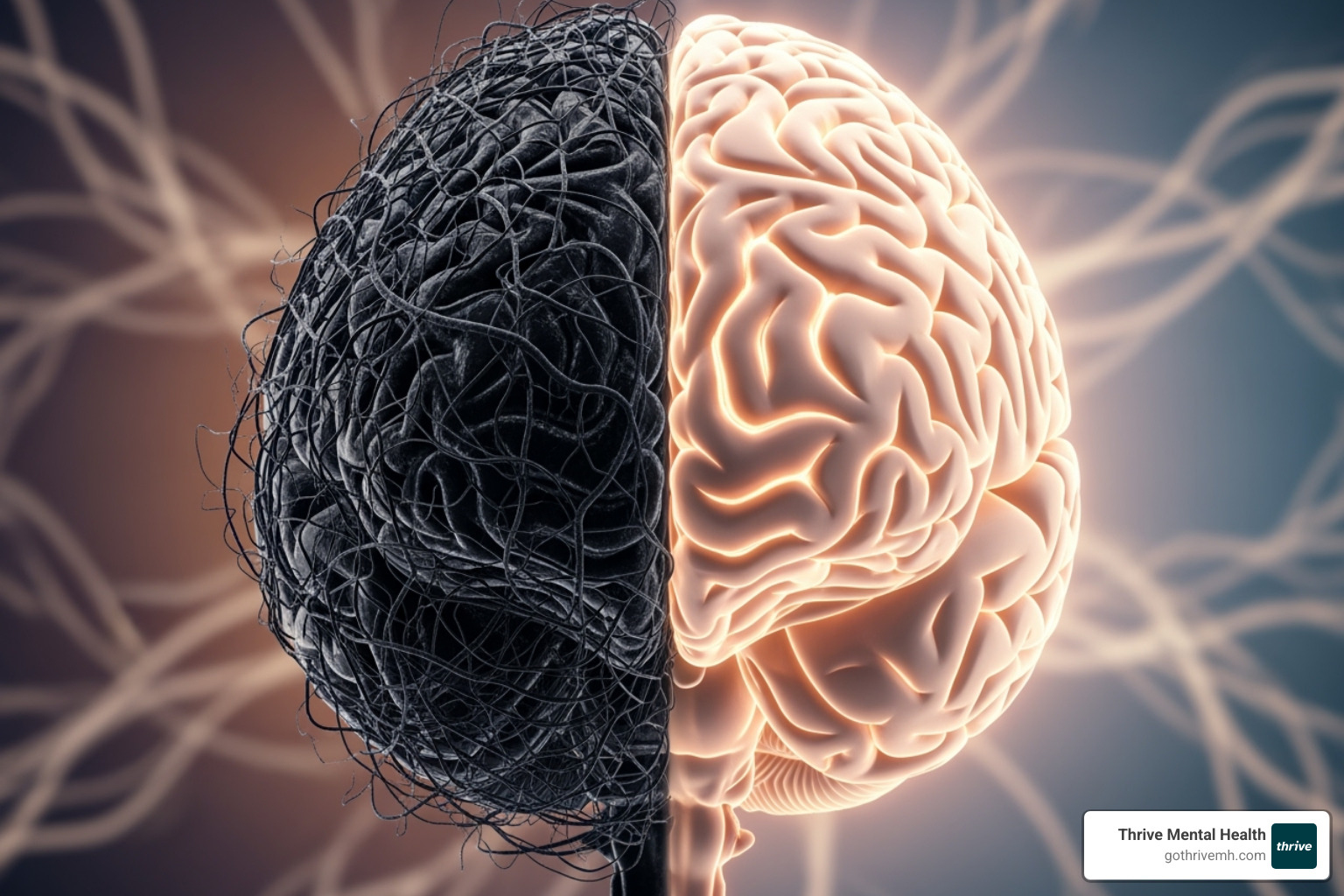CBT and EMDR Together—Why Two Therapies Are Better Than One

A Combination of CBT and EMDR Would Be Treatment For 2x
Beyond Talk Therapy—A Powerful Combination for Deep Healing
A combination of CBT and EMDR would be treatment for a wide range of mental health conditions. This integrated approach targets the root causes of distress by processing past trauma while building present-moment coping skills for daily life.
Here’s what conditions benefit most from combining these two evidence-based therapies:
- PTSD and Complex Trauma – Processing traumatic memories while building resilience skills
- Anxiety and Panic Disorders – Addressing underlying triggers and managing current symptoms
- Depression with Trauma History – Healing past wounds while changing negative thought patterns
- Chronic Pain with Emotional Components – Reprocessing trauma stored in the body while developing coping strategies
- Substance Use Recovery – Processing underlying trauma while building relapse prevention skills
When you’re stuck in patterns that talk therapy alone can’t break, this two-pronged approach offers something powerful: EMDR processes the stuck memories from your past, while CBT gives you the tools to handle your present and future.
Research shows this combination can significantly reduce depression and anxiety scores, lower PTSD symptoms, and improve overall quality of life—often faster than either therapy alone.
I’m Anna Green, LMHC, LPC, and as Thrive’s Chief Clinical Officer, I’ve seen how this integrated approach helps clients with complex needs. My training has shown me that sustainable healing requires addressing both past wounds and present challenges simultaneously.

Simple a combination of cbt and emdr would be treatment for glossary:
Understanding the Two Pillars: What Are EMDR and CBT?
Think of healing like renovating a house. CBT teaches you to maintain your current space—creating systems that work day-to-day. EMDR goes deeper, repairing foundational cracks that have affected the whole structure for years.
When a combination of CBT and EMDR would be treatment for your specific struggles, you’re getting both the immediate tools and the deep repair work your mind needs to truly thrive.

The “How-To” Manual for Your Mind: Cognitive Behavioral Therapy (CBT)
CBT is a practical, structured therapy that gives you concrete skills for daily use. It helps you change the thought patterns that keep you stuck.
Here’s what makes CBT so powerful: your thoughts, feelings, and behaviors are all connected. Change one, and you influence the others. If you constantly think “I’m going to mess this up,” CBT helps you catch that thought, examine it, and replace it with something more balanced.
CBT tackles cognitive distortions—unhelpful ways your brain interprets situations, like catastrophizing or all-or-nothing thinking. It teaches you to spot these patterns and challenge them with evidence.
The beauty of CBT lies in its skill-building approach. You’ll learn cognitive restructuring (reframing thoughts), behavioral activation (doing positive activities), and coping mechanisms for when life gets overwhelming. It’s like learning to be your own therapist.
Want to dive deeper? Check out our A Beginner’s Guide to Cognitive Behavioral Therapy (CBT) and find How CBT Can Transform Negative Thought Patterns.
Opening up and Reprocessing Trauma: Eye Movement Desensitization and Reprocessing (EMDR)
EMDR leverages your brain’s natural ability to heal. Your brain wants to process difficult memories, but sometimes it gets stuck.
The Adaptive Information Processing (AIP) model explains that when trauma occurs, the memory may not be filed away properly. It stays “live,” complete with the original sights, sounds, and emotions. This is why a seemingly random trigger can cause a flashback or panic attack.
During EMDR, you’ll focus on a distressing memory while your therapist guides you through bilateral stimulation—usually eye movements, but it can also be sounds or gentle tapping. This activates both sides of your brain, helping it reprocess the stuck memory naturally.
EMDR follows eight careful phases, moving you through preparation, assessment, desensitization, and reprocessing. The goal isn’t to erase your memories—it’s to take away their emotional sting. You’ll still remember what happened, but it won’t feel like it’s happening right now.
After successful EMDR, people often say, “It’s just information now, not this overwhelming thing that controls me.” The memory becomes part of your story rather than something that hijacks your present.
Learn more about these powerful techniques in Exploring EMDR Therapy Techniques for Trauma Recovery and our comprehensive guide to Eye Movement Desensitization and Reprocessing.
The Synergy: How CBT and EMDR Work Together for Comprehensive Treatment
These two approaches don’t just work side by side—they improve each other. EMDR specializes in processing deeply embedded traumatic memories that keep triggering you, while CBT focuses on practicing new skills to handle whatever life throws at you today.

This complementary nature fills therapeutic gaps. For example, EMDR can process a car accident memory to stop panic attacks from loud noises, while CBT teaches you how to manage anxiety in other situations. This holistic approach heals from the inside out while building real-world coping skills.
When therapists combine these methods, clients often experience better emotional regulation because they’re not constantly triggered by unprocessed memories. Plus, they have practical tools for cognitive restructuring when unhelpful thoughts arise. It’s like having both a great immune system and a well-stocked medicine cabinet.
Addressing the Root and the Symptoms
Here’s where the magic really happens. EMDR targets the root trauma that’s been feeding your current struggles, while CBT handles the daily coping strategies you need right now. It’s addressing your past, present, and future all at once.
For example, if you feel “not good enough,” EMDR can process a core memory, like being humiliated by a teacher. Once that memory loses its emotional power, CBT helps you challenge the “not good enough” thought when it appears during a work presentation.
This dual approach leads to improved self-awareness because you understand both where your patterns came from and how to interrupt them. You’re building resilience not just by healing old wounds, but by developing confidence that you can handle whatever comes next.
The result? Many people find they’re not just surviving—they’re actually thriving. For those curious about other body-focused approaches to trauma, our guide on Somatic Therapy vs EMDR: Which is Right for You? explores additional options.
A Practical Example of Integrated Therapy
Let me walk you through how this looks in a real therapy session. A combination of CBT and EMDR would be treatment for someone like Sarah, who came to us struggling with anxiety and self-doubt after difficult relationships.
First, we use CBT to identify negative core beliefs. Sarah and her therapist found she believed “I always choose the wrong people” and “I can’t trust my own judgment.” They mapped out how these thoughts led to isolation and self-doubt.
Next, we use EMDR to target the memories fueling those beliefs. Sarah identified key memories—her parents’ messy divorce, a betrayal by a friend, and an emotionally abusive relationship. Using bilateral stimulation, her therapist helped her process these memories until they felt less emotionally charged.
Finally, we use CBT skills to reinforce new, positive beliefs in daily life. As old memories lost their grip, Sarah began developing new beliefs like, “I’m learning to make healthier choices.” Her therapist used CBT techniques like behavioral experiments and thought records to help these new beliefs take root in her everyday life.
This back-and-forth process continued, with each EMDR session making space for healthier thinking, and each CBT skill helping Sarah feel more confident.
What Conditions a Combination of CBT and EMDR Would Be Treatment For
When mental health challenges are rooted in the past but disrupt your daily life, a combination of CBT and EMDR would be treatment for these complex issues. This integrated approach is ideal when symptoms stem from both unprocessed trauma and unhelpful thought patterns, offering a deep-cleaning for old wounds and a maintenance routine for ongoing wellness.

Why a combination of CBT and EMDR would be treatment for PTSD and Complex Trauma
PTSD and Complex Trauma are where this therapeutic partnership truly shines. If you’re experiencing flashbacks, intrusive thoughts, or hypervigilance, your logical mind may know you’re safe, but your nervous system hasn’t gotten the message.
EMDR targets those stuck traumatic memories that keep triggering your internal alarm system. Research shows remarkable results: patients receiving combined CBT and EMDR showed significantly lower PTSD scores compared to routine treatment (P < 0.001). They also showed higher post-traumatic growth scores, meaning they experienced positive psychological changes beyond their baseline.
Meanwhile, CBT provides the daily toolkit to challenge trauma-related beliefs like “I’m always in danger.” It helps you recognize and change responses to old programming. This is especially helpful for Complex Trauma, as it addresses both the deep emotional wounds and resulting relationship patterns.
The integration ensures you’re not just processing memories in therapy—you’re building resilience for real life. For a deeper understanding, explore our guide: Understanding Post-Traumatic Stress Disorder Symptoms, Causes, and Treatment Options.
How a combination of CBT and EMDR would be treatment for Anxiety and Panic Disorders
Anxiety and panic disorders often involve a cycle of mental threats and physical reactions. Even when not obviously trauma-related, they have underlying triggers or learned patterns. A combination of CBT and EMDR would be treatment for breaking this cycle.
CBT excels at helping you understand the anxiety machine—how catastrophic thoughts fuel physical symptoms, which then reinforce more anxious thoughts. It teaches you to catch “what if” scenarios and provides exposure techniques to reclaim avoided activities.
EMDR addresses the emotional triggers feeding your anxiety. This could be a specific panic attack that created a lasting fear, or other memories of feeling unsafe. Research shows EMDR can be highly effective for desensitizing these anxiety triggers.
The combination is comprehensive: EMDR reduces the emotional charge of triggers, while CBT provides tools to manage arousal and challenge anxious thoughts. This partnership is effective for tackling specific phobias, like fear of flying.
Learn more about CBT’s approach to anxiety in our article: Cognitive Behavioral Therapy: A Deep Dive into How It Battles Anxiety and Depression.
Tackling Depression and Low Self-Esteem
Depression, especially when combined with low self-esteem, creates stubborn suffering. It benefits from a dual approach: processing old wounds and building new patterns of thinking and behaving.
CBT tackles daily depression symptoms through behavioral activation—re-engaging with meaningful activities—and by challenging negative self-talk that fuels hopelessness.
EMDR processes the underlying emotional pain that often fuels depression, such as experiences of loss, rejection, or invalidation. When these memories are stuck, they continue to whisper lies about your self-worth. EMDR helps transform them into integrated experiences that no longer define you.
The research is compelling: patients receiving combined CBT and EMDR showed significantly lower depression and anxiety scores (P < 0.001). They also experienced improved quality of life scores, particularly in psychological health and social relationships (P < 0.01). This suggests addressing both cognitive patterns and emotional burdens creates lasting, meaningful change.
Find more about CBT’s broader mental health benefits in our guide: The Benefits of CBT in Mental Health Treatment.
Is This Integrated Approach Right for You? [Benefits & Considerations]
Deciding on the right therapy can be overwhelming. Understanding the advantages of a combined approach can clarify your options. When considering if a combination of CBT and EMDR would be treatment for your needs, it’s helpful to weigh the benefits against practical considerations like accessibility and insurance.
The Proven Benefits of Combining Therapies
The integration of EMDR and CBT creates a powerful approach that addresses both deep emotional wounds and daily challenges. Think of it as having a surgeon to remove the problem and a physical therapist to rebuild strength.
CBT alone offers great tools, but improvement is gradual. EMDR alone offers rapid relief from trauma but may lack daily coping skills. A combination of CBT and EMDR would be treatment for those who need both: deep processing from EMDR and practical skills from CBT.
| Feature | Standalone CBT | Standalone EMDR | Integrated Treatment (CBT + EMDR) |
|---|---|---|---|
| Speed of Relief | Gradual, focuses on present-day symptom reduction | Often rapid for specific traumatic memories | Potentially accelerated, comprehensive relief |
| Skill Building | Excellent for practical coping and thought change | Less direct focus on daily coping skills | Combines deep processing with robust practical skill development |
| Depth of Processing | Addresses cognitive and behavioral patterns | Deeply processes maladaptively stored memories | Addresses both surface symptoms and root traumatic experiences |
| Holistic Healing | Focuses on cognitive/behavioral aspects | Focuses on emotional/memory processing | Promotes comprehensive healing of mind, emotions, and behavior |
| Relapse Prevention | Strong through learned coping strategies | Strong through memory desensitization | Improved by addressing both triggers and underlying vulnerabilities |
This combination leads to comprehensive healing that addresses both the emotional impact of past events and the cognitive patterns that keep you stuck. Many clients need less overall treatment time and experience a lower incidence of relapse because they’ve addressed root causes and built robust coping strategies.
Insurance and Accessibility for Treatment
Accessibility and cost are common concerns. The good news is that both CBT and EMDR are evidence-based, so most major insurance providers like Cigna, Optum, Florida Blue, and Aetna offer coverage.
At Thrive Mental Health, we work with a wide variety of insurance plans to make our services accessible. Our team helps verify your benefits upfront—no surprises or hidden costs.
Finding a qualified therapist trained in both EMDR and CBT is crucial. Our expert-led clinicians specialize in these modalities and know how to weave them together effectively for our clients in Florida. We also offer flexible virtual therapy options, making it easier to access care from home, whether you’re in Miami, Orlando, Tampa, or anywhere else across the state.
Our virtual and hybrid Intensive Outpatient Programs (IOP) and Partial Hospitalization Programs (PHP) are designed to provide structured, evidence-based care to residents throughout Florida. These programs are customized to your individual needs, and we even offer evening options for busy professionals.
Frequently Asked Questions about Combined CBT and EMDR Therapy
When you’re considering whether a combination of CBT and EMDR would be treatment for your specific situation, you likely have practical questions about how this integrated approach actually works. These are the most common questions I hear from clients exploring this powerful therapeutic combination.
Can you do EMDR and CBT at the same time?
Yes. A skilled therapist integrates both into a cohesive treatment plan, strategically using each approach when it’s most beneficial. Often, CBT is used first to build coping skills and emotional stability. After EMDR sessions process difficult memories, CBT helps integrate these changes into daily life. This ensures you always have the tools to manage your healing journey.
Which is better for anxiety, EMDR or CBT?
Both are highly effective. The best choice depends on the source of the anxiety. EMDR is often better for anxiety rooted in specific traumatic events, as it processes the core memory and reduces its emotional charge. CBT excels at managing generalized anxiety by teaching practical skills to challenge anxious thoughts and behaviors in real-time. Combining them is often ideal, offering deep processing of triggers (EMDR) and daily management skills (CBT) for more complete and lasting relief.
How long does combined EMDR and CBT therapy take?
The timeline depends on your individual needs, but integration can often accelerate healing. CBT typically takes 5-20 sessions, while EMDR can show results in as few as 3 sessions for single-incident trauma. For complex issues, it takes longer. A combined approach is customized, with the therapies enhancing each other to create more efficient and durable results. The goal is to address root causes and build lasting skills, which can mean fewer sessions overall and better relapse prevention.
{
"@context": "https://schema.org",
"@type": "FAQPage",
"mainEntity": [
{
"@type": "Question",
"name": "Can you do EMDR and CBT at the same time?",
"acceptedAnswer": {
"@type": "Answer",
"text": "Yes. A skilled therapist integrates both into a cohesive treatment plan, strategically using each approach when it's most beneficial. Often, CBT is used first to build coping skills and emotional stability. After EMDR sessions process difficult memories, CBT helps integrate these changes into daily life."
}
},
{
"@type": "Question",
"name": "Which is better for anxiety, EMDR or CBT?",
"acceptedAnswer": {
"@type": "Answer",
"text": "Both are highly effective. EMDR is often better for anxiety rooted in specific traumatic events, as it processes the core memory and reduces its emotional charge. CBT excels at managing generalized anxiety by teaching practical skills to challenge anxious thoughts and behaviors in real time. Combining them is often ideal."
}
},
{
"@type": "Question",
"name": "How long does combined EMDR and CBT therapy take?",
"acceptedAnswer": {
"@type": "Answer",
"text": "Timelines vary, but integration can accelerate healing. CBT typically takes 5–20 sessions, while EMDR can show results in as few as 3 sessions for single-incident trauma. For complex issues, it takes longer. The combined approach aims to address root causes and build lasting skills."
}
}
]
}
Take the Next Step Toward Comprehensive Healing
Taking that first step toward healing takes courage. At Thrive Mental Health, we see you—not just your symptoms—and we’re here to walk alongside you with evidence-based care that creates lasting change.
A combination of CBT and EMDR would be treatment for the complex challenges you’re facing, addressing deep wounds from your past while equipping you with practical skills for your present and future. This isn’t about quick fixes. It’s about comprehensive healing that honors both where you’ve been and where you want to go.
Our two-pronged approach recognizes that sustainable recovery happens when we process stuck memories while simultaneously building the coping skills that help you thrive. Whether you’re battling PTSD, wrestling with anxiety, or working through depression, our expert-led team understands that your path to wellness needs to be as individual as you are.
We believe healing shouldn’t be limited by geography or rigid schedules. That’s why we offer virtual and hybrid IOP/PHP programs with evening options across Florida, making expert care accessible whether you’re in Jacksonville, St. Petersburg, or a smaller community. Our flexible approach means you can get the intensive support you need while maintaining the life you’re building right here in the Sunshine State.
Your insurance likely covers this life-changing treatment. We work with major providers like Cigna, Optum, Florida Blue, and Aetna to make sure financial barriers don’t stand between you and the care you deserve.
Ready for support? Thrive offers virtual and hybrid IOP/PHP with evening options. Verify your insurance in 2 minutes (no obligation) → Start benefits check or call 561-203-6085. If you’re in crisis, call/text 988.
Experiencing abuse? The Domestic Violence Hotline is available at 1-800-799-SAFE (7233).
Struggling with substance use? SAMHSA National Helpline offers support at 1-800-662-HELP (4357).